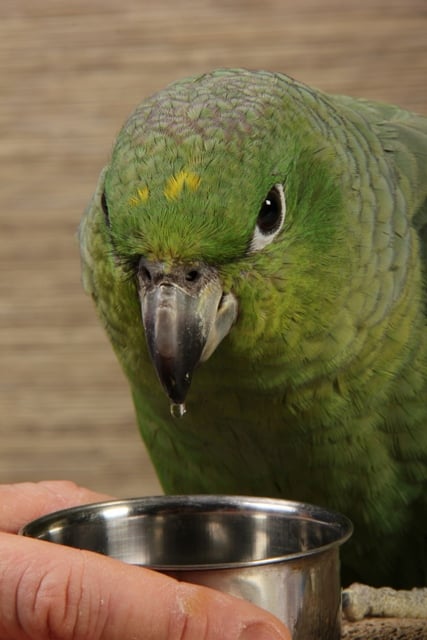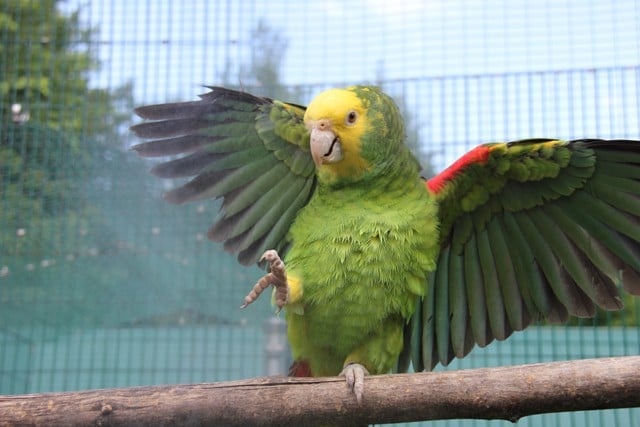Your cart is currently empty!

HARI Official Brand Site

Yet there is much more to water and your parrot’s water needs than the obvious.
Sounds simple, doesn’t it? “Provide plenty of fresh water for drinking”. Yet there is much more to water and your parrot’s water needs than the obvious. Should you be using purified or filtered water; should you add vitamins and/or minerals; how about the addition of sanitizing agents to fight viruses, yeasts or bacteria? How about water containers – a water bottle, a tube-style water dispenser, a nipple waterer, a plain cup, or a bathing dish? How many? Where? What about bathing and showering?
Although I speak to many parrot owners about the advisability of using bottled or filtered water, in general my advice is based on what you would do for yourself. If you are on a city water system, you can generally assume that water safe for human consumption is okay for pets too. Some humans don’t think much of their city water however, and purchase all kinds of filters and purifiers or commercially obtained “spring” water. If you feel strongly about this issue, go ahead and use these more costly water strategies for your pet parrot too. However, large parrot breeders can rarely justify the use of such systems. Fortunately, we certainly do not see a lot in the medical literature to suggest that water from city systems or wells that have been approved for human consumption can cause problems in birds. Water from hoses, barrels, or stored in open plastic containers can become contaminated with bacteria – always use water from a fresh running source whenever possible. A much bigger problem in terms of contamination has nothing to do with the source but everything to do with the water’s fate once it leaves the tap.

Water stays safe for drinking when bacteria, viruses, and other micro-organisms are not present in large numbers. Protecting the water from air-borne contamination – or more direct contaminants – is important. Always place drinking cups or bathing dishes as far away from an overhead perch as possible. If you frequently find feces in the water, move the dish. Hooded dishes, water bottles, and nipple waterers (boxes or multiple line waterers with a metal peg that is moved upwards in a metal sleeve to obtain a spurt of water drops) are also available, but they have a down-side in that they can be harder to sanitize. Yet water bottles and other devices which reduce the surface area of drinking water available for contamination (via feces or airborne fecal particles) will normally reduce problems with many common infectious diseases. Training your parrot to use a water bottle is usually simple. Even my gouldian finches learned how to use a water bottle within a day or two, and they are not exactly known for their high intellect! No nuclear scientist careers for those two. To train them however, I simply placed the water bottle above their regular water dish (emptied), and squeezed the bottle gently until a drop was actually hanging from the spout. Your bird will likely figure it out shortly, but choose an introduction time when you can be home to closely monitor the bird to ensure that it is drinking. Water bottles must have their water changed daily, just as you would with a dish. Just taste old water from a water bottle and see how much you like it! Plus, bottles occasionally develop an air bubble in the spout, making the bottle look full, but preventing the parrot from getting any water at all. A daily change ensures that no parrot goes without water too long, as well as keeping the water hygienic and palatable. For most water containers, a double set should be purchased. This means that a clean and dry container is always ready to go, leaving you with more time to clean the other dish – even allows for use of the dishwasher, which is a great option. Don’t just empty the water dish or cup, rinse it, and re-fill. Bacteria like Pseudomonas find this no obstacle.
Try and avoid using vitamin and mineral preparations in the water for extended periods of time. The official position of the Association of Avian Veterinarians is to favour the use of good nutrition through enriched formulated diets, or to use supplements for use with seed eating birds by placing them on green or soft foods. This means that the water can be left clean and fresh. If you do use a supplement of some kind in the water, it means you should likely change the water more frequently. Some bacteria or other microorganisms may grow more quickly in nutrient-enriched water, thus necessitating more frequent changes.

Don’t neglect bathing and early bathing training for your parrot. Even desert-dwelling species such as some of the Australian psittacines experience a rainy season and seem to benefit from showers or misting. Phoebe Greene Linden and Sally Blanchard (both respected authorities on early parrot behavior and development), have often been quoted on this subject. They feel that all pet parrot species benefit from a very early introduction into the joys of bathing. A wet mother bird is simulated with a warm wet washcloth, and later a pre-weaning exposure to gentle, warm misting is performed. The babies are carefully protected from chilling or from negative or fearful experiences with bathing. They recommend that young parrots being introduced to misting or bathing be done so in stages, starting with a fine mist just directed at the feet or in the general vicinity of the parrot. Wing and tail flipping is your signal that the bird is ready for more. Plant sprayers can be scary for many birds; try a silent “pressurized” garden mister instead. These large misters are available at garden stores and are primed with a pump in the lid. Then a silent, fine mist emerges noiselessly when the trigger is depressed later. I like to wait for a sunny day or a situation where I know the birds will dry quickly and safely. Then out comes the power mister, much to the delight of my bird collection. Don’t neglect cleanliness for misters and sprayers too. One study showed that stagnant water in a sprayer was a source of a Pseudomonas outbreak in a colony of finches. The benefits when using clean water make the extra effort very worthwhile. Show breeders have believed for decades that a glorious sheen can be brought to the plumage of the exhibition parakeet by regular bathing prior to a show. Let’s all try it!
Louise Bauck BSc, DVM, MVSc.

Follow our easy-to-use daily diet plan to ensure that your feathered friend receives the necessary nutrients every day.